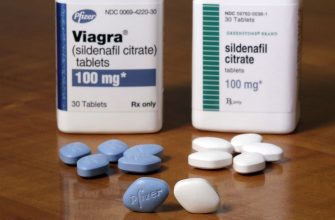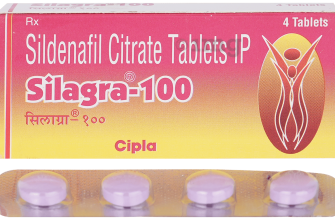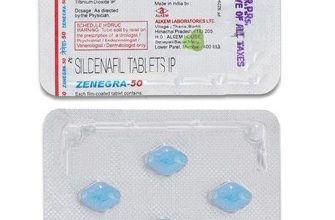If you’re considering how Silagra can complement Metformin in managing diabetes, this combination presents a promising avenue. Silagra, primarily known for treating erectile dysfunction, contains Sildenafil, which improves blood flow. This effect may enhance physical activity, contributing positively to metabolic functions.
Studies indicate that combining these medications may aid in managing some symptoms of diabetes-related complications. Metformin is widely recognized for its ability to lower blood sugar levels and improve insulin sensitivity. When paired with Silagra, patients might experience improved overall well-being, as enhanced circulation can promote better health outcomes.
Always consult with your healthcare provider before initiating any new treatment plan. Understanding how Silagra interacts with Metformin ensures proper management of your condition. Monitoring your health closely while on these medications helps identify any potential side effects early on.
- Comprehensive Guide to Silagra Metformin
- Understanding Metformin: Mechanism of Action
- Effects on Intestinal Absorption
- Influence on Gut Microbiota
- Benefits of Combining Silagra and Metformin
- Recommended Dosages and Administration Guidelines
- Administration Tips
- Monitoring and Adjustments
- Potential Side Effects of Silagra Metformin
- Serious Reactions
- Drug Interactions
- Contraindications and Cautions for Use
- Contraindications
- Cautions
- Interaction with Other Medications
- Patient Experiences and Testimonials
- Real Patient Feedback
- Common Themes in Testimonials
- Importance of Lifestyle Changes Alongside Treatment
- Regular Monitoring and Consultation
- Prioritize Sleep and Stress Management
Comprehensive Guide to Silagra Metformin
Silagra, containing sildenafil, and metformin, a common medication for diabetes management, are often discussed together in the context of treating sexual dysfunction in diabetic patients. Combining these medications can enhance sexual health while managing blood sugar levels.
Dosage Recommendations: For Silagra, the typical starting dose is 50 mg, taken approximately one hour before sexual activity. Adjustments may be made based on individual effectiveness and tolerance, with a maximum dose of 100 mg. Metformin usually starts at 500 mg once or twice daily, increasing gradually based on blood glucose readings.
Benefits: This combination allows individuals with diabetes not only to address erectile dysfunction but also to stabilize glucose levels. Improved sexual function can lead to enhanced quality of life and psychological well-being.
Potential Side Effects: Be aware of common side effects like headaches and gastrointestinal issues from metformin, along with possible flushing and nasal congestion from Silagra. Monitoring your body’s reactions to both medications is crucial.
Interactions: Always inform your healthcare provider about all medications you are taking. Some heart medications and certain antifungal drugs may interact with Silagra. Keeping a comprehensive list ensures safe management.
Lifestyle Considerations: Incorporating lifestyle changes, such as a balanced diet and regular exercise, can enhance the benefits of both medications. Staying active contributes to better blood sugar control and overall cardiovascular health, further supporting sexual function.
Consulting a Healthcare Provider: Regular follow-ups are necessary to assess efficacy and adjust dosages as needed. Open communication about any side effects or concerns will help tailor your treatment plan effectively.
Using Silagra and metformin together can significantly improve the quality of life for individuals with diabetes. Proactive management and professional guidance will enable successful outcomes.
Understanding Metformin: Mechanism of Action
Metformin primarily lowers blood glucose levels by decreasing hepatic glucose production and enhancing insulin sensitivity. This compound reduces the amount of glucose released by the liver, particularly during fasting states. As a result, people with type 2 diabetes experience improved glycemic control.
Effects on Intestinal Absorption
Metformin also impacts the gastrointestinal tract by reducing the absorption of glucose from food. This action helps in minimizing postprandial (after-meal) blood sugar spikes, contributing to more stable glucose levels throughout the day.
Influence on Gut Microbiota
Recent studies indicate that metformin alters gut microbiota composition, which may play a role in enhancing insulin sensitivity and reducing inflammation. These changes in gut bacteria can also lead to increased production of short-chain fatty acids like butyrate, supporting metabolic health.
In summary, metformin’s multifaceted approach–lowering hepatic glucose output, improving insulin sensitivity, reducing intestinal glucose absorption, and modifying gut microbiota–materially contributes to its effectiveness in managing type 2 diabetes.
Benefits of Combining Silagra and Metformin
Combining Silagra and Metformin offers targeted benefits for individuals with both erectile dysfunction and type 2 diabetes. This combination can enhance sexual performance while simultaneously aiding in blood sugar control.
Silagra, which contains Sildenafil, improves blood flow, leading to better erections. When paired with Metformin, which helps regulate glucose levels, patients may experience improved sexual health without compromising diabetes management. Studies suggest that better sexual function can enhance overall well-being for those managing chronic conditions.
This combination may reduce the psychological impact of erectile dysfunction for diabetics. Regaining confidence in sexual health can lead to healthier relationships, which are important for emotional support and mental health. Furthermore, managing both conditions simultaneously can simplify treatment plans, allowing patients to take fewer medications over time.
Safety profiles of both Silagra and Metformin are well-established, reducing concerns about drug interactions. However, consulting with a healthcare professional before starting any new treatment regimen is crucial to ensure personalized care and optimal dosing.
In summary, the synergy between Silagra and Metformin can lead to improved outcomes in sexual health and diabetes management, contributing to a better quality of life.
Recommended Dosages and Administration Guidelines
The typical starting dose of Silagra is 50 mg, taken as needed approximately 30 minutes to 1 hour before sexual activity. If needed, the dosage may be increased to a maximum of 100 mg or decreased to 25 mg, depending on individual response and tolerance.
Metformin usually starts at a dose of 500 mg to 1000 mg daily, administered with meals to minimize gastrointestinal discomfort. Dose adjustments may occur based on blood glucose monitoring, with common maintenance doses ranging from 1500 mg to 2000 mg daily, divided into two or three doses.
Administration Tips
Silagra should not be taken more than once per day. Avoid excessive alcohol consumption, as it may increase the risk of side effects. Metformin administration is also best accompanied by food to enhance absorption and reduce side effects.
Monitoring and Adjustments
Regular follow-ups are crucial. Prioritize monitoring blood sugar levels while on metformin, adjusting the dosage as necessary. Discuss any unusual symptoms with your healthcare provider to determine if dosage adjustments are needed for Silagra.
Potential Side Effects of Silagra Metformin
Silagra combined with metformin may lead to specific side effects, which require attention. Monitor your body’s reactions after starting this medication. The common side effects to be aware of include gastrointestinal issues like nausea, vomiting, and diarrhea. Adjusting the dosage or taking the medication with food can help alleviate these symptoms.
Serious Reactions
In some cases, more severe effects may occur, such as lactic acidosis, a rare but serious condition. Symptoms to watch for include unusual fatigue, muscle pain, difficulty breathing, and abdominal discomfort. If these symptoms arise, seek medical help immediately.
Drug Interactions
Silagra and metformin can interact with other medications, amplifying the risk of side effects. Inform your healthcare provider about all medications and supplements you are currently taking. This ensures a safe treatment plan tailored to your needs.
Contraindications and Cautions for Use
Silagra combined with metformin presents specific contraindications and precautions that users must understand to ensure safety and efficacy.
Contraindications
- Patients with a known hypersensitivity to sildenafil or metformin should avoid this combination.
- Individuals with severe renal impairment must not use this combination as it can worsen kidney function.
- Heart conditions, such as unstable angina or recent heart attack, prohibit the use of Silagra.
- Pregnant or breastfeeding women should avoid these medications unless prescribed by a healthcare provider.
Cautions
- Monitor blood sugar levels closely, as metformin can cause changes that may require dosage adjustments.
- Regular liver function tests are advisable for individuals with pre-existing liver conditions.
- Consider potential interactions with other medications, particularly nitrates and antihypertensives, which may increase the risk of side effects.
- Consult a healthcare professional prior to combining with other treatments for erectile dysfunction or diabetes.
Stay informed and prioritize communication with healthcare providers to adjust treatment plans based on individual health profiles.
Interaction with Other Medications
Silagra and metformin can interact with several medications. Always inform your healthcare provider about all the medications you are taking, including over-the-counter drugs and supplements.
Silagra, primarily used for erectile dysfunction, can potentially enhance the effects of nitrates, leading to a significant drop in blood pressure. Avoid using them together. This combination can result in symptoms like dizziness, fainting, or a rapid heartbeat.
Metformin, used for managing diabetes, can interact with certain medications like corticosteroids, diuretics, and specific blood pressure medications. These interactions may elevate blood sugar levels or increase the risk of lactic acidosis.
Below is a table summarizing key interactions between Silagra, metformin, and other medications:
| Medication | Interaction Type | Recommendation |
|---|---|---|
| Nitrates | Increased risk of hypotension | Avoid combining with Silagra |
| Corticosteroids | May increase blood sugar levels | Monitor blood glucose closely |
| Diuretics | Potential risk of lactic acidosis | Consult your doctor for monitoring |
| Alpha-blockers | Possible additive effects on blood pressure | Use caution and monitor |
Regular check-ups and laboratory tests can help manage and minimize potential interactions. Always discuss any concerns with your healthcare provider before starting new medications.
Patient Experiences and Testimonials
Many patients have shared their positive experiences with Silagra metformin in managing their conditions. Here’s what some of them have to say:
Real Patient Feedback
- John, 54: “After starting Silagra metformin, I noticed my blood sugar levels stabilizing within weeks. The side effects were minimal, and I felt more energetic than before.”
- Lisa, 43: “I was hesitant to try Silagra, but my doctor assured me of its benefits. Since incorporating it into my routine, my A1C levels have shown significant improvement.”
- Mike, 60: “The combination of Silagra and metformin has been a game changer for me. My cravings for sugary snacks have decreased, helping me lose weight and feel healthier.”
Common Themes in Testimonials
- Improved Blood Sugar Control: Many report better management of their blood glucose levels.
- Weight Management: Several patients have successfully lost weight while on this medication.
- Increased Energy Levels: Users often feel more energetic and less fatigued.
Patients advise keeping track of blood glucose levels regularly and maintaining a balanced diet for optimal results. Consulting healthcare providers for personalized guidance is also highly recommended. Overall, personal accounts highlight the positive impact of Silagra metformin, encouraging others to explore this option with their doctors.
Importance of Lifestyle Changes Alongside Treatment
Incorporate regular physical activity into your routine. Aim for at least 150 minutes of moderate exercise each week, such as brisk walking or cycling. This not only aids in weight management but enhances insulin sensitivity, promoting better blood sugar control.
Adjust your dietary habits. Focus on whole foods, including plenty of vegetables, whole grains, lean proteins, and healthy fats. Reducing refined sugars and carbohydrates can stabilize your blood sugar levels, which is crucial while taking medications like Silagra or Metformin.
Regular Monitoring and Consultation
Schedule routine check-ups with your healthcare provider. Monitoring your blood glucose levels will help you understand how lifestyle changes affect your readings. Discuss any adjustments in your treatment plan based on your progress and health status.
Prioritize Sleep and Stress Management
Establish a consistent sleep schedule, aiming for 7-9 hours of quality sleep each night. Lack of sleep can disrupt your body’s hormonal balance, affecting insulin response. Implement stress-reducing practices such as meditation, yoga, or deep-breathing exercises to enhance your overall well-being.
Engage with a support network, whether through family, friends, or support groups. Sharing experiences and strategies can motivate you to stay on track with lifestyle changes, complementing your medical treatment effectively.










